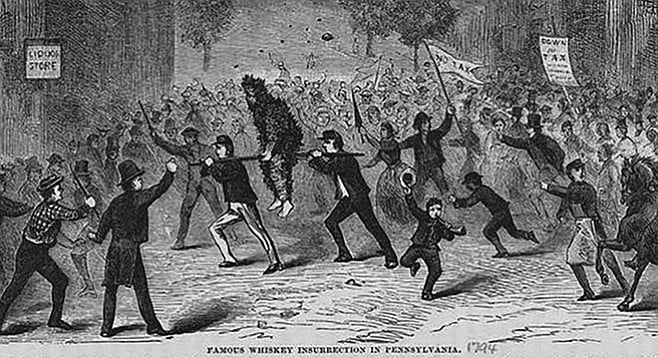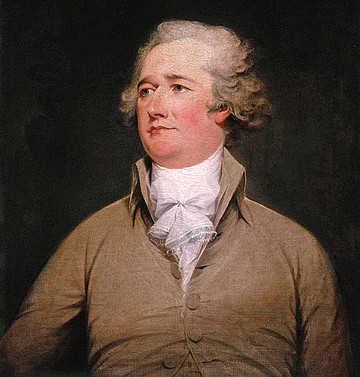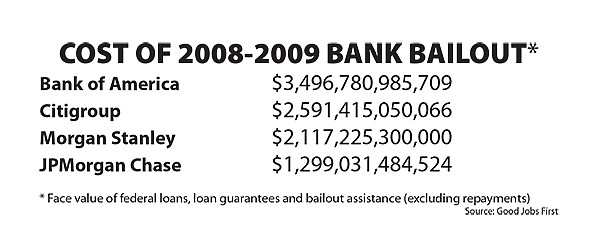 Facebook
Facebook
 X
X
 Instagram
Instagram
 TikTok
TikTok
 Youtube
Youtube

Welfare for corporations is one of our most rancid economic problems. Who is to blame? Surprise! Alexander Hamilton, our first secretary of the treasury. He is beloved on Broadway these days, but Appalachian moonshiners may rightfully disdain him for sins of the past. In 1791, swayed by Hamilton’s oratory, the United States put a stiff tax on whiskey. The indigent farmers in western Pennsylvania had been producing their own whiskey. The tax was a burden on them because they paid twice the rate that the established, rich Eastern distillers paid. The Eastern plutocrat distillers loved the tax because it drove the cheaper bootleg booze out of the market.

The Whiskey Rebellion was the result. The moonshiners took up arms to thwart federal tax collectors. President George Washington led 13,000 militiamen to quell the revolt. Finally, there was a détente. But a pecking order was established: well-heeled corporations and individuals are first in line for favors. Hamilton became known as the nation’s first champion of big business, lover of subsidies, and corporate welfare booster.
Getting information on corporate welfare is difficult. Both governments and corporations find ways to hide subsidies. Last August, the Governmental Accounting Standards Board approved a new set of rules making it harder for governments to conceal subsidies to business. Still, “It’s hard to make estimates,” says professor Kenneth Thomas at the University of Missouri–St. Louis, one of the experts in the field. “I would say there has been some decline in corporate welfare, but it is mostly related to the ebbs and flow of the economy” rather than new accounting rules, he says. This year’s subsidy data will be published next year.
There are various estimates on the size of corporate welfare. Tad DeHaven of the libertarian Cato Institute says that in 2012 alone, federal subsidies were about $100 billion. The subsidies were doled out by a number of federal sources: the Departments of Agriculture, Commerce, Defense, Energy, Housing and Urban Development, Interior, State, Transportation, and miscellaneous government offices such as the Appalachian Regional Commission, Export-Import Bank, International Trade Commission, and National Science Foundation.
Good Jobs First is a research organization based in Washington DC. It says that since the year 2000, the federal government has awarded $68 billion in grants and allocated tax credits to companies.
There is a big difference between $100 billion in one year and $68 billion in 15 years. Phil Mattera, research director of Good Jobs First, says the difference relates to methodology. Groups such as Cato ferret out “welfare provisions in the Internal Revenue Code,” he says. That approach omits the specific companies receiving the handouts. Mattera’s organization counts only data “that can be attributed to individual companies.” His group looks for specific grants to companies and is more conservative — actually, understated.
Some researchers believe state and local governments provide an estimated $50 billion of annual handouts to the private sector. Others say that estimate is quite high.

Consider the Great Recession of late 2007– early 2009. The Congress, and particularly the Federal Reserve, our central bank, bailed out the big banks. Bank of America got $3.5 trillion; Citigroup, $2.6 trillion; Morgan Stanley, $2.1 trillion; and JPMorgan Chase, $1.3 trillion in loans, loan guarantees, and bailout assistance.
The total annual economic output (gross domestic product) of the United States last year was $18 trillion. Yet in the 2008 collapse, we extended more than half that sum, $9.5 trillion, to four of our largest financial institutions, says Good Jobs First.
Do you want to see what Bank of America’s bailout looks like on paper? $3,496,780,985,709.
Mattera cautions that much of the bailout money loaned to banks has been paid back, but it still counts as welfare.

Federal contractors make products for the federal government — say, ships, drones, military uniforms. These contracts are not corporate welfare. But many of these contractors also get grants and allocated tax credits, which are corporate welfare. Among contractors, General Electric has received the biggest pile of money in government subsidies, according to Good Jobs First. Do you know who is in second place among government contractors? General Atomics, the San Diego–based company known for its nuclear power reactor systems, drones, wireless and laser technologies, uranium mining and processing, superconducting magnets, and systems for destroying hazardous materials. Since 2000, General Atomics has received $615 million in federal government grants and tax breaks, according to Good Jobs First.
Privately held General Atomics refuses to answer any questions posed by the Reader, but Good Jobs First says the company has received nearly all its federal subsidies from the Department of Energy.
General Atomics comes in 14th among all kinds of welfare-gathering companies.
Another San Diego company, Sempra Energy, is 41st among corporate recipients of grants and allocated tax credits since 2000. The largest subsidy is for the Cameron LNG (liquefied natural gas) plant in Louisiana. Sempra has joined foreign companies in ownership of the operation. Sempra, which is investing $10 billion in the project, gets a property tax exemption for ten years. Sempra has also received subsidies for wind and solar projects and smart-grid projects, such as the Borrego Springs Microgrid operation.
A company has to spend money to rake in subsidies. The Sunlight Foundation estimates that between 2007 and 2012, America’s most politically active corporations spent a whopping $5.8 billion on lobbying and campaign contributions.
For that money, these corporations received a total of $4.4 trillion in federal business and support, including contracting. Qualcomm is 96th on that list, having spent $38.6 million on lobbying and $2.1 million on contributions in those years. General Atomics is 122nd on the list with $14.7 million on lobbying and $1.7 million on contributions.
Here’s the punchline: during this 2007–2012 period, the federal government paid $4.3 trillion to Social Security recipients. So, corporations raked in more in federal business and support than 50 million Americans got in Social Security payments (not including Medicare) over the same period.
Yes, excessive social welfare is a severe economic problem. But so is corporate welfare and corporate contracts won through heavy lobbying and gifts to politicians. Corporate welfare strains federal, state, and local budgets, and the expenditures are artfully concealed, particularly on the state and local levels.
What’s needed is a major study to indicate whether corporate welfare exceeds social welfare. Trouble is, the only organization with the money and manpower to do such a study is the federal government, and it doesn’t want to know.


Welfare for corporations is one of our most rancid economic problems. Who is to blame? Surprise! Alexander Hamilton, our first secretary of the treasury. He is beloved on Broadway these days, but Appalachian moonshiners may rightfully disdain him for sins of the past. In 1791, swayed by Hamilton’s oratory, the United States put a stiff tax on whiskey. The indigent farmers in western Pennsylvania had been producing their own whiskey. The tax was a burden on them because they paid twice the rate that the established, rich Eastern distillers paid. The Eastern plutocrat distillers loved the tax because it drove the cheaper bootleg booze out of the market.

The Whiskey Rebellion was the result. The moonshiners took up arms to thwart federal tax collectors. President George Washington led 13,000 militiamen to quell the revolt. Finally, there was a détente. But a pecking order was established: well-heeled corporations and individuals are first in line for favors. Hamilton became known as the nation’s first champion of big business, lover of subsidies, and corporate welfare booster.
Getting information on corporate welfare is difficult. Both governments and corporations find ways to hide subsidies. Last August, the Governmental Accounting Standards Board approved a new set of rules making it harder for governments to conceal subsidies to business. Still, “It’s hard to make estimates,” says professor Kenneth Thomas at the University of Missouri–St. Louis, one of the experts in the field. “I would say there has been some decline in corporate welfare, but it is mostly related to the ebbs and flow of the economy” rather than new accounting rules, he says. This year’s subsidy data will be published next year.
There are various estimates on the size of corporate welfare. Tad DeHaven of the libertarian Cato Institute says that in 2012 alone, federal subsidies were about $100 billion. The subsidies were doled out by a number of federal sources: the Departments of Agriculture, Commerce, Defense, Energy, Housing and Urban Development, Interior, State, Transportation, and miscellaneous government offices such as the Appalachian Regional Commission, Export-Import Bank, International Trade Commission, and National Science Foundation.
Good Jobs First is a research organization based in Washington DC. It says that since the year 2000, the federal government has awarded $68 billion in grants and allocated tax credits to companies.
There is a big difference between $100 billion in one year and $68 billion in 15 years. Phil Mattera, research director of Good Jobs First, says the difference relates to methodology. Groups such as Cato ferret out “welfare provisions in the Internal Revenue Code,” he says. That approach omits the specific companies receiving the handouts. Mattera’s organization counts only data “that can be attributed to individual companies.” His group looks for specific grants to companies and is more conservative — actually, understated.
Some researchers believe state and local governments provide an estimated $50 billion of annual handouts to the private sector. Others say that estimate is quite high.

Consider the Great Recession of late 2007– early 2009. The Congress, and particularly the Federal Reserve, our central bank, bailed out the big banks. Bank of America got $3.5 trillion; Citigroup, $2.6 trillion; Morgan Stanley, $2.1 trillion; and JPMorgan Chase, $1.3 trillion in loans, loan guarantees, and bailout assistance.
The total annual economic output (gross domestic product) of the United States last year was $18 trillion. Yet in the 2008 collapse, we extended more than half that sum, $9.5 trillion, to four of our largest financial institutions, says Good Jobs First.
Do you want to see what Bank of America’s bailout looks like on paper? $3,496,780,985,709.
Mattera cautions that much of the bailout money loaned to banks has been paid back, but it still counts as welfare.

Federal contractors make products for the federal government — say, ships, drones, military uniforms. These contracts are not corporate welfare. But many of these contractors also get grants and allocated tax credits, which are corporate welfare. Among contractors, General Electric has received the biggest pile of money in government subsidies, according to Good Jobs First. Do you know who is in second place among government contractors? General Atomics, the San Diego–based company known for its nuclear power reactor systems, drones, wireless and laser technologies, uranium mining and processing, superconducting magnets, and systems for destroying hazardous materials. Since 2000, General Atomics has received $615 million in federal government grants and tax breaks, according to Good Jobs First.
Privately held General Atomics refuses to answer any questions posed by the Reader, but Good Jobs First says the company has received nearly all its federal subsidies from the Department of Energy.
General Atomics comes in 14th among all kinds of welfare-gathering companies.
Another San Diego company, Sempra Energy, is 41st among corporate recipients of grants and allocated tax credits since 2000. The largest subsidy is for the Cameron LNG (liquefied natural gas) plant in Louisiana. Sempra has joined foreign companies in ownership of the operation. Sempra, which is investing $10 billion in the project, gets a property tax exemption for ten years. Sempra has also received subsidies for wind and solar projects and smart-grid projects, such as the Borrego Springs Microgrid operation.
A company has to spend money to rake in subsidies. The Sunlight Foundation estimates that between 2007 and 2012, America’s most politically active corporations spent a whopping $5.8 billion on lobbying and campaign contributions.
For that money, these corporations received a total of $4.4 trillion in federal business and support, including contracting. Qualcomm is 96th on that list, having spent $38.6 million on lobbying and $2.1 million on contributions in those years. General Atomics is 122nd on the list with $14.7 million on lobbying and $1.7 million on contributions.
Here’s the punchline: during this 2007–2012 period, the federal government paid $4.3 trillion to Social Security recipients. So, corporations raked in more in federal business and support than 50 million Americans got in Social Security payments (not including Medicare) over the same period.
Yes, excessive social welfare is a severe economic problem. But so is corporate welfare and corporate contracts won through heavy lobbying and gifts to politicians. Corporate welfare strains federal, state, and local budgets, and the expenditures are artfully concealed, particularly on the state and local levels.
What’s needed is a major study to indicate whether corporate welfare exceeds social welfare. Trouble is, the only organization with the money and manpower to do such a study is the federal government, and it doesn’t want to know.
Comments